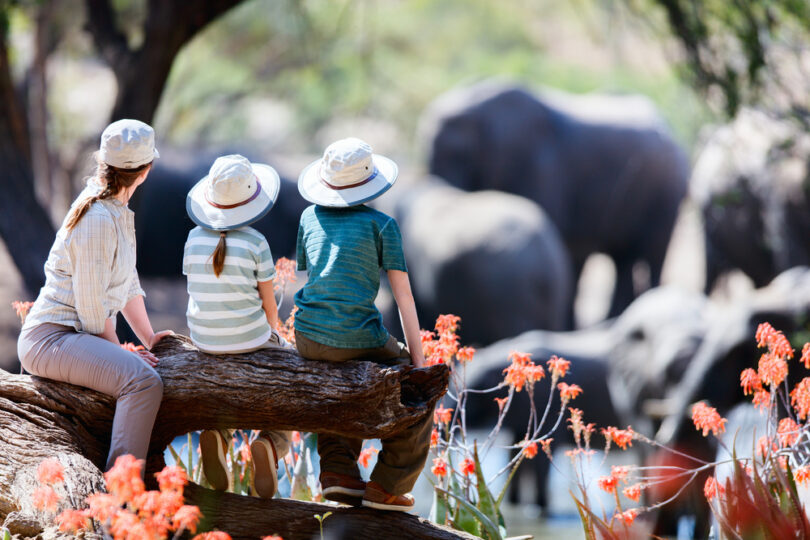An African safari is more than just a vacation. It’s an experience that immerses you in some of the most awe-inspiring landscapes and wildlife encounters on Earth. Whether you dream of watching lions stalk their prey on the Serengeti, gliding through Botswana’s Okavango Delta in a traditional mokoro canoe, or trekking deep into the rainforests of Uganda for a face-to-face moment with a mountain gorilla, there’s a safari for every kind of traveler.
But with so many options, choosing the right destination can feel overwhelming. Some places offer easy logistics and year-round wildlife sightings, while others provide remote, off-the-beaten-path adventures. In this guide, we’ll break down some of Africa’s top safari destinations, what sets them apart, and what you need to know before embarking on your journey.
South Africa

Leopard
South Africa is often the first stop for safari newcomers, thanks to its well-developed tourism industry, diverse landscapes, and a range of options that suit different budgets and travel styles. The country’s most famous wildlife destination, Kruger National Park, is home to the iconic Big Five — lions, elephants, leopards, rhinos, and buffalo. Unlike many safari destinations where fully guided tours are the only option, Kruger allows for both self-drive safaris and guided expeditions, making it ideal for travelers who want flexibility. Well-maintained roads and clear signage make navigating the park relatively easy, though hiring a guide improves your chances of spotting elusive animals.
For those seeking a more exclusive experience, Sabi Sands Game Reserve, adjacent to Kruger, offers intimate, luxurious lodges and expert-led game drives, with some of the best leopard sightings in Africa. Madikwe Game Reserve, on the border of Botswana, provides another upscale option, with malaria-free safaris—an important consideration for families with young children.
What makes South Africa special is the sheer variety of experiences you can add to your safari. Cape Town, the Cape Winelands, and the dramatic coastline of the Garden Route make excellent extensions to a wildlife adventure. Whether you want a classic safari, a self-drive expedition, or high-end luxury, South Africa delivers an accessible yet unforgettable experience.
Kenya

Giraffe Centre, Kenya, Africa
Kenya is one of Africa’s most legendary safari destinations, offering incredible wildlife encounters and diverse landscapes. Its national parks and private conservancies provide a mix of well-known highlights and off-the-beaten-path experiences, making it a top choice for both first-time visitors and seasoned safari-goers. The crown jewel of Kenya’s safari circuit is the Masai Mara, famous for its vast open plains and abundant predators. Between July and October, it becomes the stage for the Great Migration, one of the most dramatic wildlife spectacles on Earth. Over a million wildebeest, along with zebras and gazelles, move in search of fresh grazing, often crossing the crocodile-infested Mara River. Game drives here offer a front-row seat to the action, with frequent sightings of lions, cheetahs, and leopards.
For a different perspective, a hot-air balloon safari at dawn reveals the landscape in breathtaking detail, with sweeping views of elephants and giraffes moving across the savanna below. Amboseli National Park, another must-visit destination, is renowned for its large elephant herds and stunning views of Mount Kilimanjaro.
Before you head into the wild, Nairobi offers meaningful wildlife experiences. The David Sheldrick Wildlife Trust rescues and rehabilitates orphaned elephants, while the Giraffe Centre provides an opportunity to see endangered Rothschild’s giraffes up close. Many Kenyan safari operators work closely with Maasai communities, ensuring that tourism supports local conservation and cultural preservation.
Tanzania

Rhinos in Ngorongoro crater Tanzania
Tanzania offers some of the most spectacular safari experiences in Africa, with vast wilderness areas and an incredible diversity of wildlife. From the sweeping plains of the Serengeti to the dramatic crater of Ngorongoro, the country’s parks provide unforgettable encounters in breathtaking settings. The Serengeti plain is the heart of Tanzania’s safari scene, famous for its endless grasslands and abundant predators. It is also a key part of the Great Migration, where massive herds of wildebeest, zebras, and gazelles move in search of fresh grazing. Lions, cheetahs, and hyenas closely follow, creating thrilling opportunities for wildlife viewing. Game drives here offer classic African safari moments, whether you visit during the migration or in quieter months when resident wildlife is still plentiful.
For a completely different landscape, the Ngorongoro Crater provides a distinctive safari experience. This massive volcanic caldera is home to a high concentration of animals, including elephants, hippos, and rare black rhinos. The crater’s enclosed environment makes wildlife sightings almost guaranteed, offering one of the best chances to see a wide variety of animals in a single day.
Botswana

Okavango Delta, Botswana
Botswana offers one of Africa’s most exclusive safari experiences, with vast, unspoiled landscapes and a strong commitment to conservation. Low-impact tourism policies keep visitor numbers small, ensuring a more intimate and immersive encounter with wildlife.
At the heart of Botswana’s safari scene is the Okavango Delta, a UNESCO World Heritage site and one of the most unusual ecosystems in the world. Seasonal floodwaters transform the delta into a lush, water-filled paradise, attracting elephants, hippos, antelope, and an astonishing variety of bird species. Unlike traditional vehicle-based safaris, the best way to explore the delta is by mokoro, a traditional dugout canoe. Gliding silently through narrow channels and lily-covered lagoons offers a rare, up-close view of the animals that inhabit this watery wilderness.
For a more classic game-drive experience, Chobe National Park is home to some of Africa’s largest elephant herds, often seen congregating along the Chobe River. Further south, the remote Kalahari Desert provides a stark contrast to the wetlands, with towering sand dunes, salt pans, and resilient desert wildlife, including oryx, meerkats, and black-maned Kalahari lions.
Namibia

Oryx (Oryx gazella), Damaraland, Kunene, Namibia
In Namibia, dramatic deserts, towering dunes, and rugged mountains create a stunning backdrop for wildlife encounters. Its vast, sparsely populated terrain gives a sense of true wilderness, making it perfect for travelers seeking solitude and adventure. The iconic red dunes of Sossusvlei rise sharply against the sky, forming some of the world’s highest sand dunes. Despite the harsh environment, desert-adapted wildlife such as oryx, springbok, and even elusive leopards thrive here. In Etosha National Park, waterholes act as magnets for elephants, lions, rhinos, and giraffes, offering some of Africa’s best wildlife viewing, especially during the dry season.
For those looking beyond traditional safaris, Damaraland provides an opportunity to track desert-adapted elephants and lions, while the Skeleton Coast offers eerie shipwrecks and sprawling seal colonies along its fog-shrouded shores. The surreal landscapes of Twyfelfontein, a UNESCO-listed site, reveal ancient rock engravings left behind by early hunter-gatherers. Namibia’s strong focus on eco-tourism and community-run conservancies ensures that tourism directly benefits both wildlife and local people.
Uganda

Mountain gorilla, Mgahinga National Park, Uganda
A safari in Uganda goes beyond the typical game drive, drawing visitors into lush rainforests and remote savannas. While less famous than its neighbors, the country’s diverse landscapes and distinctive wildlife encounters make it a rewarding destination for adventurous travelers. The highlight of any Ugandan safari is gorilla trekking in Bwindi Impenetrable National Park. Hiking through dense jungle to observe a family of mountain gorillas in their natural habitat is one of Africa’s most humbling and unforgettable experiences. The trek can be physically demanding, but the moment you lock eyes with a silverback is well worth the effort. Kibale National Park offers another primate encounter, with the chance to track wild chimpanzees as they swing through the treetops.
For a more traditional safari, Queen Elizabeth National Park features classic game drives with elephants, lions, and hippos, while the remote Kidepo Valley National Park offers dramatic landscapes and a true off-the-beaten-path wilderness experience. The Kazinga Channel, teeming with hippos and crocodiles, can be explored by boat for a different perspective on the wildlife. Uganda’s conservation efforts ensure that tourism directly supports wildlife protection and local communities.
Madagascar

Lemurs, Madagascar
Madagascar offers a wildlife experience completely different from the mainland, with ecosystems and species found nowhere else on Earth. Separated from Africa for millions of years, the island has evolved into a biodiversity hotspot where 90% of its wildlife is endemic. The biggest draw is Madagascar’s famous lemurs, from the acrobatic sifakas to the wide-eyed nocturnal aye-ayes. Andasibe-Mantadia National Park provides one of the best chances to see them, with guided treks through lush rainforest where the haunting calls of the indri lemur echo through the trees.
Madagascar’s remote nature means tourism is still developing, and infrastructure can be challenging. However, choosing eco-conscious tour operators helps protect its fragile environments and supports local conservation efforts.
Q: What is the best time to go on a safari in Africa?
A: The best time depends on the destination. For East Africa (Kenya and Tanzania), the dry season from June to October is ideal, especially for the Great Migration in the Masai Mara. Southern Africa (South Africa, Botswana, Namibia) is best from May to September when wildlife gathers around water sources.
Q: How many days do you need for a safari?
A: A minimum of three to five days is recommended for a fulfilling safari experience. For destinations like the Serengeti or Kruger, a week allows for deeper exploration and better wildlife sightings.
Q: What should I pack for a safari?
A: Light, breathable clothing in neutral colors, comfortable walking shoes, a good pair of binoculars, a wide-brimmed hat, sunscreen, insect repellent, and a camera with extra batteries. Layers are important since early mornings and evenings can be chilly.
Q: Are safaris safe?
A: Yes, as long as you follow guidelines from your safari guide. Wildlife encounters are thrilling but require caution — never leave the vehicle during game drives and always listen to your guide’s instructions. Most parks and lodges have strict safety protocols to ensure a secure experience.
Q: Ready for Your Safari Adventure?
A: Africa’s landscapes, wildlife, and cultures offer experiences you won’t find anywhere else. Whether you dream of witnessing the Great Migration in Kenya, tracking gorillas in Uganda, or gliding through Botswana’s Okavango Delta, the perfect safari is waiting for you.
Have you ever been on an African safari before? Do share your experience with us in the comments below!








